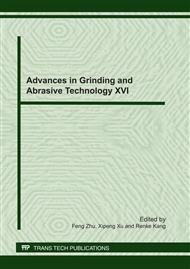p.257
p.263
p.268
p.273
p.278
p.283
p.289
p.293
p.298
Investigation of Elastic Deformation Machining Method for Aspheric Surface Generation
Abstract:
The mechanics of elasticity is a novel aspheric fabrication technology that could transform aspheric optical fabrication technology into sphere optical fabrication technology. The shape accuracy of the optical lens changes significantly with deformation conditions and various parameters of machining process. Considering Polymethyl-methacrylate (acrylic PMMA) characteristic and elastic deformation aspheric surface generated by the load is uniformly distributed over the inner portion of the plate, the investigation of elastic deformation machining method for aspheric surface generation is introduced in this paper. The subject of this study is to determine finished surface shape of acrylic after lapping process. The experiment results are compared with the finite element analysis (FEA) and theoretical results. The mentioned finite element models were established using the software Abaqus/CAE. The experiment result showed that the error of deformation curves between analytical and experimental result is smaller than FEA and experimental result. The theoretical of deformation curves obtained close to the experiment curves. The results indicate that the experimental investigation of elastic deformation machining method can be used to fabricate the aspheric surface with simple machining process and high efficiency.
Info:
Periodical:
Pages:
278-282
Citation:
Online since:
July 2011
Authors:
Keywords:
Price:
Сopyright:
© 2011 Trans Tech Publications Ltd. All Rights Reserved
Share:
Citation:


